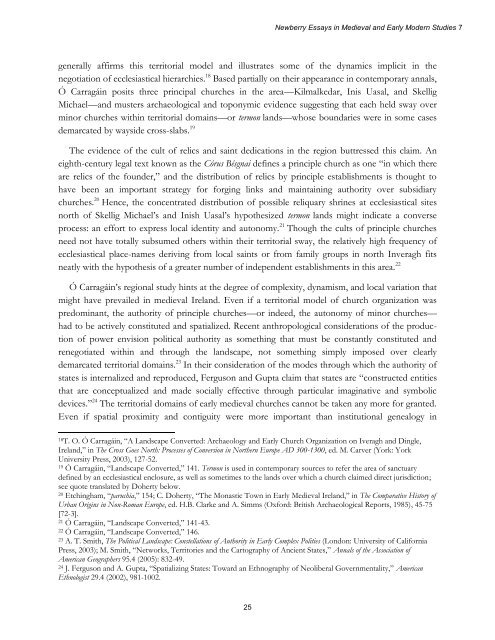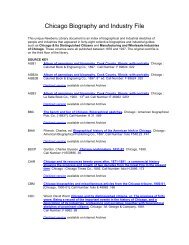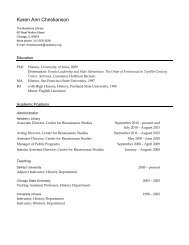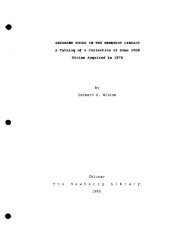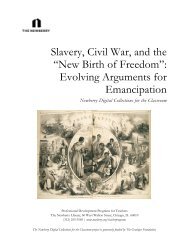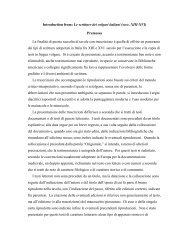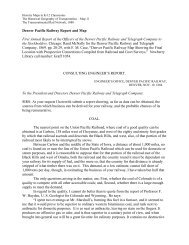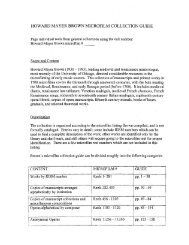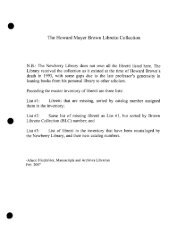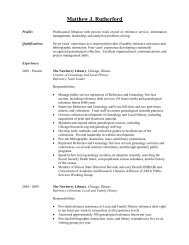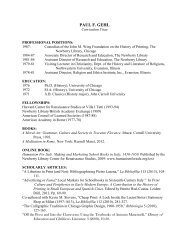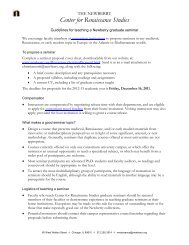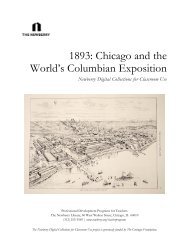Newberry Essays in Medieval and Early Modern ... - Newberry Library
Newberry Essays in Medieval and Early Modern ... - Newberry Library
Newberry Essays in Medieval and Early Modern ... - Newberry Library
Create successful ePaper yourself
Turn your PDF publications into a flip-book with our unique Google optimized e-Paper software.
<strong>Newberry</strong> <strong>Essays</strong> <strong>in</strong> <strong>Medieval</strong> <strong>and</strong> <strong>Early</strong> <strong>Modern</strong> Studies 7generally affirms this territorial model <strong>and</strong> illustrates some of the dynamics implicit <strong>in</strong> thenegotiation of ecclesiastical hierarchies. 18 Based partially on their appearance <strong>in</strong> contemporary annals,Ó Carragá<strong>in</strong> posits three pr<strong>in</strong>cipal churches <strong>in</strong> the area—Kilmalkedar, Inis Uasal, <strong>and</strong> SkelligMichael—<strong>and</strong> musters archaeological <strong>and</strong> toponymic evidence suggest<strong>in</strong>g that each held sway overm<strong>in</strong>or churches with<strong>in</strong> territorial doma<strong>in</strong>s—or termon l<strong>and</strong>s—whose boundaries were <strong>in</strong> some casesdemarcated by wayside cross-slabs. 19The evidence of the cult of relics <strong>and</strong> sa<strong>in</strong>t dedications <strong>in</strong> the region buttressed this claim. Aneighth-century legal text known as the Córus Bésgnai def<strong>in</strong>es a pr<strong>in</strong>ciple church as one “<strong>in</strong> which thereare relics of the founder,” <strong>and</strong> the distribution of relics by pr<strong>in</strong>ciple establishments is thought tohave been an important strategy for forg<strong>in</strong>g l<strong>in</strong>ks <strong>and</strong> ma<strong>in</strong>ta<strong>in</strong><strong>in</strong>g authority over subsidiarychurches. 20 Hence, the concentrated distribution of possible reliquary shr<strong>in</strong>es at ecclesiastical sitesnorth of Skellig Michael’s <strong>and</strong> Inish Uasal’s hypothesized termon l<strong>and</strong>s might <strong>in</strong>dicate a converseprocess: an effort to express local identity <strong>and</strong> autonomy. 21 Though the cults of pr<strong>in</strong>ciple churchesneed not have totally subsumed others with<strong>in</strong> their territorial sway, the relatively high frequency ofecclesiastical place-names deriv<strong>in</strong>g from local sa<strong>in</strong>ts or from family groups <strong>in</strong> north Inveragh fitsneatly with the hypothesis of a greater number of <strong>in</strong>dependent establishments <strong>in</strong> this area. 22Ó Carragá<strong>in</strong>’s regional study h<strong>in</strong>ts at the degree of complexity, dynamism, <strong>and</strong> local variation thatmight have prevailed <strong>in</strong> medieval Irel<strong>and</strong>. Even if a territorial model of church organization waspredom<strong>in</strong>ant, the authority of pr<strong>in</strong>ciple churches—or <strong>in</strong>deed, the autonomy of m<strong>in</strong>or churches—had to be actively constituted <strong>and</strong> spatialized. Recent anthropological considerations of the productionof power envision political authority as someth<strong>in</strong>g that must be constantly constituted <strong>and</strong>renegotiated with<strong>in</strong> <strong>and</strong> through the l<strong>and</strong>scape, not someth<strong>in</strong>g simply imposed over clearlydemarcated territorial doma<strong>in</strong>s. 23 In their consideration of the modes through which the authority ofstates is <strong>in</strong>ternalized <strong>and</strong> reproduced, Ferguson <strong>and</strong> Gupta claim that states are “constructed entitiesthat are conceptualized <strong>and</strong> made socially effective through particular imag<strong>in</strong>ative <strong>and</strong> symbolicdevices.” 24 The territorial doma<strong>in</strong>s of early medieval churches cannot be taken any more for granted.Even if spatial proximity <strong>and</strong> contiguity were more important than <strong>in</strong>stitutional genealogy <strong>in</strong>18 T. O. Ó Carragá<strong>in</strong>, “A L<strong>and</strong>scape Converted: Archaeology <strong>and</strong> <strong>Early</strong> Church Organization on Iveragh <strong>and</strong> D<strong>in</strong>gle,Irel<strong>and</strong>,” <strong>in</strong> The Cross Goes North: Processes of Conversion <strong>in</strong> Northern Europe AD 300-1300, ed. M. Carver (York: YorkUniversity Press, 2003), 127-52.19 Ó Carragá<strong>in</strong>, “L<strong>and</strong>scape Converted,” 141. Termon is used <strong>in</strong> contemporary sources to refer the area of sanctuarydef<strong>in</strong>ed by an ecclesiastical enclosure, as well as sometimes to the l<strong>and</strong>s over which a church claimed direct jurisdiction;see quote translated by Doherty below.20 Etch<strong>in</strong>gham, “paruchia,” 154; C. Doherty, “The Monastic Town <strong>in</strong> <strong>Early</strong> <strong>Medieval</strong> Irel<strong>and</strong>,” <strong>in</strong> The Comparative History ofUrban Orig<strong>in</strong>s <strong>in</strong> Non-Roman Europe, ed. H.B. Clarke <strong>and</strong> A. Simms (Oxford: British Archaeological Reports, 1985), 45-75[72-3].21 Ó Carragá<strong>in</strong>, “L<strong>and</strong>scape Converted,” 141-43.22 Ó Carragá<strong>in</strong>, “L<strong>and</strong>scape Converted,” 146.23 A. T. Smith, The Political L<strong>and</strong>scape: Constellations of Authority <strong>in</strong> <strong>Early</strong> Complex Polities (London: University of CaliforniaPress, 2003); M. Smith, “Networks, Territories <strong>and</strong> the Cartography of Ancient States,” Annals of the Association ofAmerican Geographers 95.4 (2005): 832-49.24 J. Ferguson <strong>and</strong> A. Gupta, “Spatializ<strong>in</strong>g States: Toward an Ethnography of Neoliberal Governmentality,” AmericanEthnologist 29.4 (2002), 981-1002.25


